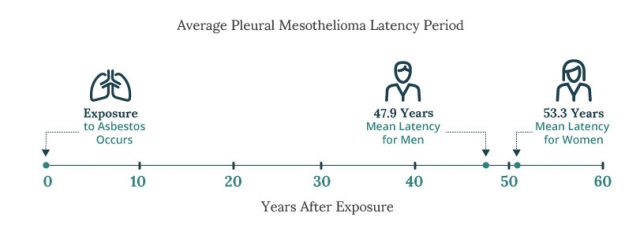For many mesothelioma patients, the latency period is several decades. This means most people diagnosed with the disease will be older adults.
The average age at diagnosis for pleural mesothelioma is 69, according to the American Cancer Society.
How Long Does it Take for Mesothelioma to Develop After Asbestos Exposure?
The mesothelioma latency period is rarely less than 15 years, although a 2018 research review found it ranges from seven to 70 years.
Figures on average mesothelioma latency vary by occupation, gender and other factors. Data from a 2018 German study found an average latency period of 38 years for all asbestos-related diseases.
A 2016 World Health Organization report described an average 40-year latency period for asbestosis, lung cancer and mesothelioma in Polish workers.
Exposure at younger ages may be associated with shorter latency periods. More intense exposures lead to shorter latency times as well.
While mesothelioma often takes 20 to 50 years to develop, a first responder to 9/11 developed symptoms and died of mesothelioma within three years of the attacks.
The asbestos fibers in the air around ground zero were very concentrated, pointing to the contribution of exposure intensity to a shorter latency period.

Which Factors Affect the Latency Period of Mesothelioma?
There are many things that can affect the amount of time between exposure to asbestos and the onset of mesothelioma cancer.
Factors that impact mesothelioma latency period include:
- Age
- Gender
- Occupation
- Timing and intensity of asbestos exposure
- Personal genetics
- Type of mineral fiber
Age
The average age of a pleural mesothelioma diagnosis is 69. This type of the disease accounts for approximately three-quarters of all cases of malignant mesothelioma.
Most experts believe this older average age reflects the generally long latency period. Theoretically, however, older age at exposure could result in a shorter latency period.
Immune function declines with age, which means the body may be less able to repair the damage when asbestos fibers make their way into the body.
For example, being exposed in your 50s could lead to a mesothelioma diagnosis within 15 to 20 years, rather than the usual three to five decades.
On the other hand, people who begin working with or around asbestos at a younger age may have a larger cumulative exposure earlier in life. This may lead to a mesothelioma diagnosis sooner rather than later.
A small subset of mesothelioma patients receives their diagnosis before age 40. Approximately 2 percent of all mesothelioma-affected individuals are in this younger group.
Gender
In this cohort, the gender distribution is nearly equivalent. Fifty-one percent of patients are male and 49 percent are female. This looks very different from older patient groups, in which males predominated, making up 78 percent of cases.
In younger patients, approximately half of cases are pleural and half are peritoneal mesothelioma. In the older patient groups, approximately 90 percent of cases are pleural.
The extremely short latency period and very different presentation of cases in young mesothelioma patients suggests potentially different pathways to disease.

Occupation
People employed in certain occupations have a high incidence of long-latency respiratory disease, including mesothelioma and asbestosis.
- Miners
- Quarrymen
- Plumbers
- Gas fitters
- Shipyard workers
- Dock employees
Electricians, plumbers and home maintenance personnel remain at high risk of exposure through work on asbestos-containing residential properties.
Various routes of exposure in these different occupations contribute significantly to how mesothelioma latency periods affect groups of people.
Timing and Intensity of Asbestos Exposure
Scientists don’t fully understand how timing of asbestos exposure during the lifespan affects mesothelioma risk and latency period, though some information is available on this topic.
A 2017 French paper describes 1,196 men with mesothelioma and 2,369 matched controls without mesothelioma, who were recruited into the study between 1987 and 2006.
The study documented that younger men with more intense asbestos exposures were associated with more than two times the risk of developing mesothelioma and possibly a shorter latency period compared with men who had the same exposure level spread out over their entire work history.
Personal Genetic Risks for Mesothelioma and Other Cancers
Compared with the more typical mesothelioma cases in older adults, the 2 percent of mesothelioma that occurs in people under age 40 looks very different.
In older age groups, the majority of cases occur in men, with most tumors in the pleura.
In younger groups, pleural and peritoneal tumors occur at roughly equal rates. The gender distribution is almost evenly divided between men and women.
Mesothelioma experts believe these differences reflect variability in the genetic susceptibility to the disease and likely play a role in the shorter latency periods seen in young-adult mesothelioma patients.
Studies of families experiencing multiple cases of mesothelioma also show the role genetic susceptibility may play in shorter latency periods.
Type of Asbestos Fibers
According to a 2018 Swedish report, the risk of mesothelioma is strongest with exposure to asbestos types from the amphibole family. This indicates latency period likely varies by the type of asbestos fiber involved in the exposure.
Studies from the U.S. and Australia indicate crocidolite asbestos, in particular, is tied to the shortest mesothelioma latency period.



